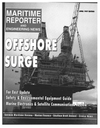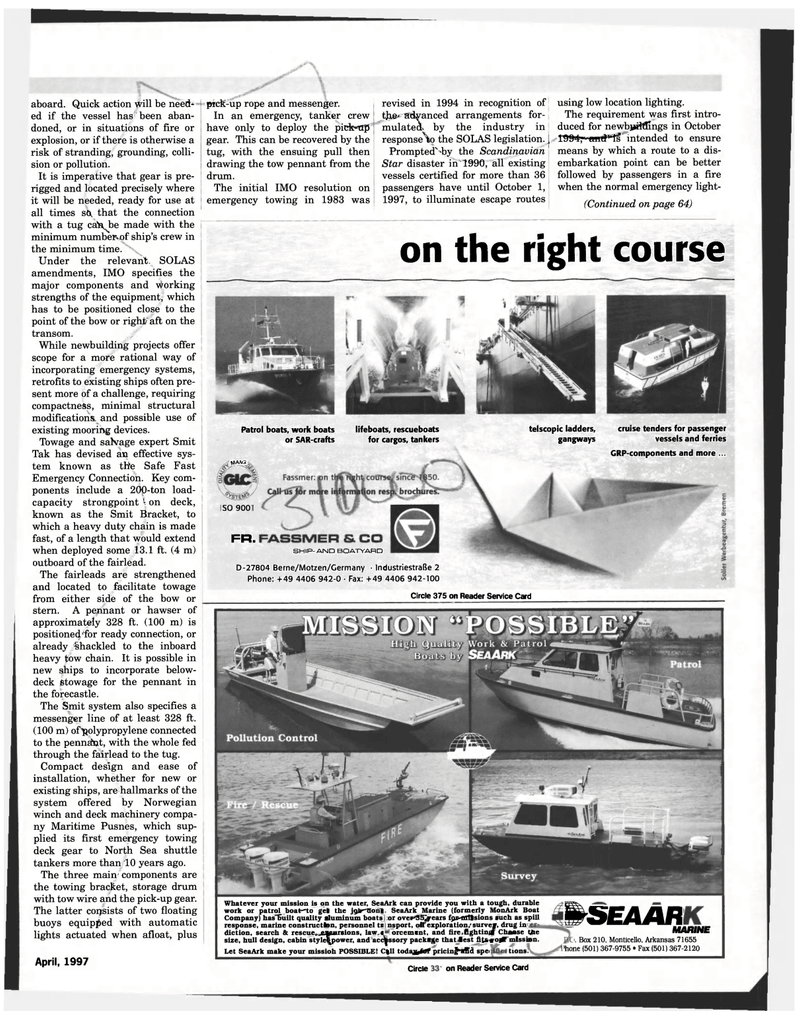
Page 53: of Maritime Reporter Magazine (April 1997)
Read this page in Pdf, Flash or Html5 edition of April 1997 Maritime Reporter Magazine
aboard. Quick action will be need- ed if the vessel has been aban- doned, or in situations of fire or explosion, or if there is otherwise a risk of stranding, grounding, colli- sion or pollution.
It is imperative that gear is pre- rigged and located precisely where it will be needed, ready for use at all times so. that the connection pn with a tug ca^be made with the minimum number of ship's crew in the minimum time.
Under the relevant. SOLAS amendments, IMO specifies the major components and forking strengths of the equipment, which has to be positioned close to the point of the bow or right* aft on the transom.
While newbuilding projects offer scope for a more rational way of incorporating emergency systems, retrofits to existing ships often pre- sent more of a challenge, requiring compactness, minimal structural modifications and possible use of existing mooring devices.
Towage and salvage expert Smit
Tak has devised an effective sys- tem known as the Safe Fast
Emergency Connection. Key com- ponents include a 20p-ton load- capacity strongpoint on deck, known as the Smit Bracket, to which a heavy duty chain is made fast, of a length that would extend when deployed some 13.1 ft. (4 m) outboard of the fairlead.
The fairleads are strengthened and located to facilitate towage from either side of the bow or rck-up rope and messenger.
In an emergency, tanker crew have only to deploy the pick^tip gear. This can be recovered by the tug, with the ensuing pull then drawing the tow pennant from the drum.
The initial IMO resolution on emergency towing in 1983 was revised in 1994 in recognition of the* advanced arrangements for- mulated by the industry in response\o the SOLAS legislation, j
Prompted by the Scandinavian
Star disaster in 1990, all existing vessels certified for more than 36 passengers have until October 1, 1997, to illuminate escape routes using low location lighting.
The requirement was first intro- duced for newbuildings in October 1^47'-«md,i^intended to ensure means by which a route to a dis- embarkation point can be better followed by passengers in a fire when the normal emergency light- (Continued on page 64) on the right course
Patrol boats, work boats or SAR-crafts lifeboats, rescueboats for cargos, tankers telscopic ladders, gangways cruise tenders for passenger vessels and ferries
GRP-components and more ... (AAM
SO 900
FR.
SHIP-AND BOATYARD
D-27804 Berne/Motzen/Germany • IndustriestraBe 2
Phone: +49 4406 942-0 • Fax: +49 4406 942-100
Circle 375 on Reader Service Card
Whatever your mission is on the water, SeaArk can provide you with a tough, durable work or patrol boat to get the jgJr-Horil
Company) has**Euilt quality aluminum boats response, marine construction, personnel tr diction, search & rescue, excursions, law < size, hull design, cabin style^power, and access
Let SeaArk make your missioh POSSIBLE! C»ll
SeaArk Marine (formerly MonArk Boat :or over 35 years fju^mttsions such as spill nsport, oil exploration, survey, drug in: orcement, and fire .fighting Choose the ssory package that best flt»-»o|ff mission. todajhf0^pricin^*afi
SEAARK
MARINE i. Box 210, Monticello, Arkansas 71655 'hone (501) 367-9755 • Fax (501) 367-2120
Circle 247 on Reader Service Card stern. A pennant or hawser of approximately 328 ft. (100 m) is positioned'for ready connection, or already Shackled to the inboard heavy tow chain. It is possible in new ships to incorporate below- deck stowage for the pennant in the forecastle.
The Smit system also specifies a messenger line of at least 328 ft. (100 m) of polypropylene connected to the pennafpt, with the whole fed through the fairlead to the tug.
Compact design and ease of installation, whether for new or existing ships, are hallmarks of the system offered by Norwegian winch and deck machinery compa- ny Maritime Pusnes, which sup- plied its first emergency towing deck gear to North Sea shuttle tankers more than 10 years ago.
The three main components are the towing bracket, storage drum with tow wire and the pick-up gear.
The latter consists of two floating buoys equipped with automatic lights actuated when afloat, plus
April, 1997 55

 52
52

 54
54
